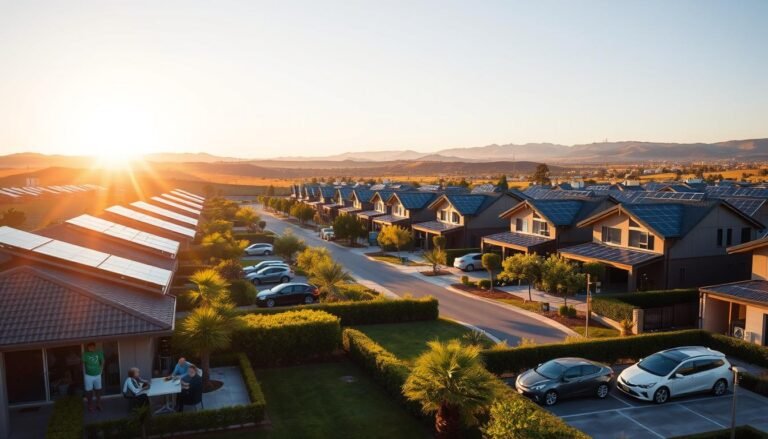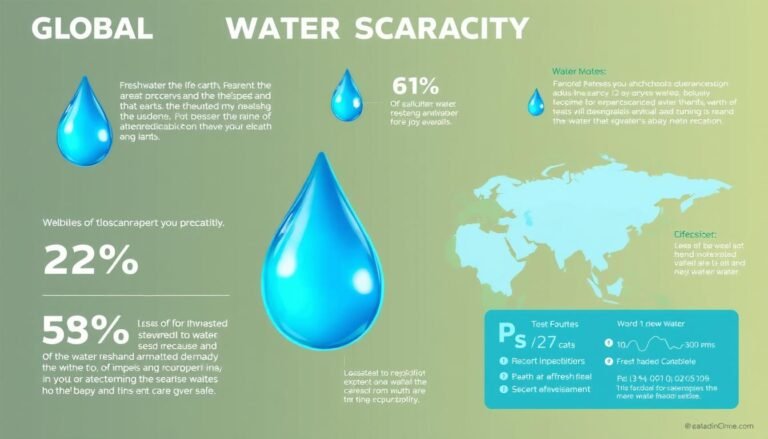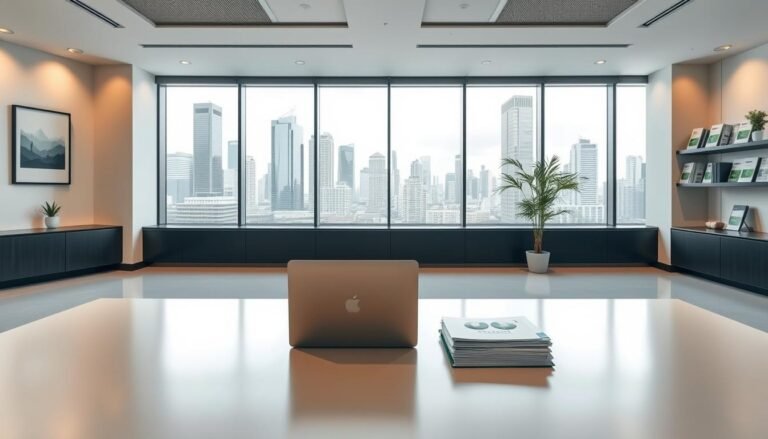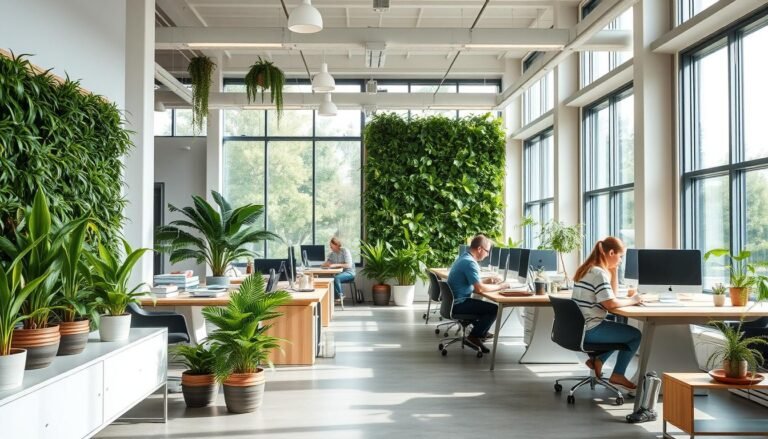As Australia continues to grow and develop, the need for eco-friendly homes has become increasingly important. With the rising awareness of environmental issues, homeowners are now seeking sustainable living solutions that not only reduce their carbon footprint but also provide a healthier living space.
The concept of sustainable housing is gaining momentum, with many Australians embracing the idea of living in harmony with the environment. This shift towards eco-friendly homes is driven by the desire to create a better future for generations to come.
Key Takeaways
- Eco-friendly homes reduce carbon footprint
- Sustainable living solutions improve overall well-being
- Australia is embracing sustainable housing designs
- Eco-friendly homes provide healthier living spaces
- Sustainable housing is the future of Australian homes
The Evolution of Eco-Friendly Architecture in Australia
The Australian architecture landscape has undergone a significant transformation with the integration of eco-friendly designs. This shift towards sustainability is evident in the growing adoption of green building practices across the country.
Historical Development of Green Building
Australia’s journey towards eco-friendly architecture began several decades ago, with early adopters focusing on energy efficiency and environmental sustainability. The National Building Code of Australia played a crucial role in setting standards for energy efficiency. Over time, the industry has seen the introduction of various green building rating systems, such as the Green Star rating system, which has become a benchmark for sustainable construction.
| Year | Milestone |
|---|---|
| 2000 | Introduction of energy efficiency standards |
| 2003 | Launch of Green Star rating system |
| 2010 | National Building Code updates for sustainability |
Current Market Growth and Consumer Demand
Today, the demand for sustainable housing designs in Australia is on the rise, driven by consumer awareness of environmental issues and the desire for energy-efficient homes. According to a recent survey, over 75% of Australian consumers are willing to pay more for sustainable housing options. As
“Sustainability is no longer a niche market, it’s becoming mainstream,”
The market is responding with innovative green architecture AU solutions, incorporating locally sourced materials and cutting-edge technology to minimize environmental impact. As the industry continues to evolve, we can expect to see even more creative and effective sustainable housing designs in Australia.
Sustainable Housing Designs Australia: Core Principles and Approaches
Australian sustainable housing designs are at the forefront of environmental conservation, incorporating holistic design philosophies that prioritize both functionality and eco-friendliness. These designs are not just about building homes; they’re about creating a sustainable future for generations to come.
Holistic Design Philosophy
A holistic design philosophy is central to sustainable housing in Australia. This approach considers the entire lifecycle of a building, from construction to occupancy, and even demolition. It involves integrating various elements such as energy efficiency, water conservation, and material sustainability to create homes that are not only eco-friendly but also comfortable and healthy living spaces.
Balancing Aesthetics with Environmental Impact
Sustainable housing designs in Australia strike a balance between aesthetics and environmental impact. Architects and builders are now more than ever focused on creating homes that are not only visually appealing but also environmentally responsible. This is achieved through the use of sustainable materials, innovative designs, and technologies that reduce the carbon footprint of the building.
Integration with Australian Landscapes
The integration of sustainable homes with the Australian landscape is a key principle of eco-friendly design. This involves designing homes that complement their surroundings, using local materials, and incorporating natural elements into the design. Such homes not only blend into their environment but also minimize their ecological footprint, preserving the natural beauty of Australia’s diverse landscapes.
By embracing these core principles and approaches, sustainable housing designs in Australia are setting a new standard for eco-friendly living, combining innovative design, environmental responsibility, and aesthetic appeal.
Climate-Responsive Design for Australian Regions
Australia’s diverse climate zones necessitate innovative climate-responsive design strategies. From the tropical north to the arid west and the temperate south, each region presents unique challenges and opportunities for sustainable housing.
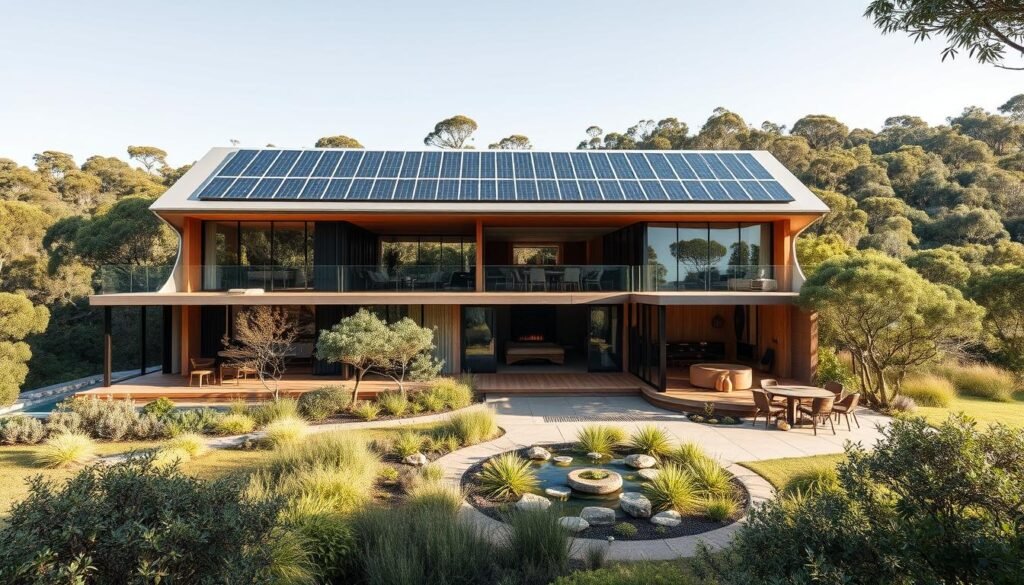
Tropical Northern Territory and Queensland Solutions
In the tropical regions, designs focus on high ceilings, large eaves, and open floor plans to maximize ventilation and reduce the need for air conditioning. Materials are chosen for their ability to withstand high humidity and intense sunlight.
Designs for Arid Central and Western Australia
For arid regions, designs incorporate thick-walled constructions and shading devices to minimize heat gain. Light-colored materials and strategic window placement help reduce cooling needs.
Southern and Coastal Region Considerations
In southern and coastal areas, designs often feature insulation and double glazing to combat cooler temperatures. The use of sustainable materials and consideration of sea-level rise are also key factors.
By adopting these climate-responsive strategies, Australian homes can be both sustainable and resilient, contributing to a greener future.
Passive Solar Design Strategies
In the pursuit of sustainable housing, passive solar design stands out as a crucial strategy for reducing energy consumption. By carefully designing homes to harness the sun’s energy, Australians can significantly decrease their reliance on mechanical heating and cooling systems.
Optimal Home Orientation for Australian Latitudes
One of the fundamental principles of passive solar design is orienting homes to maximize natural heating and cooling. In Australian latitudes, this typically means aligning the longest axis of the house east-west to maximize northern exposure. As Renzo Piano, a renowned architect, once said, “The house is a machine for living, but it’s also a device for capturing the sun.” This orientation allows for large north-facing windows to capture winter sun while minimizing summer sun exposure.
Seasonal Sun Control and Shading
Effective seasonal sun control is critical in passive solar design. This involves using shading devices such as eaves, awnings, and louvers to prevent overheating during summer months. As noted by experts, “Proper shading can reduce cooling energy consumption by up to 30%.” In contrast, allowing sunlight to enter during winter can significantly reduce heating needs.
Cross-Ventilation and Cooling Techniques
Cross-ventilation is another key strategy in passive solar design, particularly in warmer climates. By designing homes with windows and doors that allow for cross-ventilation, homeowners can reduce the need for air conditioning. Techniques such as using operable windows, clerestory windows, and solar chimneys can enhance ventilation and cooling. As observed in successful passive solar homes, “Cross-ventilation can cool a home by up to 5°C, reducing the need for mechanical cooling.”
By incorporating these passive solar design strategies, Australian homeowners can create comfortable, energy-efficient living spaces that not only reduce energy consumption but also enhance the overall living experience.
Sustainable Building Materials for Australian Conditions
Sustainable building materials play a vital role in constructing eco-friendly homes across Australia. The country’s diverse climate and environmental conditions necessitate the use of materials that are not only durable but also environmentally friendly.
Indigenous and Locally-Sourced Materials
Using indigenous and locally-sourced materials reduces transportation emissions and supports local economies. Materials such as rammed earth and reclaimed wood are not only sustainable but also provide a unique aesthetic to Australian homes.
Recycled and Repurposed Building Components
Recycling and repurposing building materials is another effective strategy. For instance, recycled glass and steel can be used in construction, reducing waste and the demand for new raw materials. According to a report by the Australian Modern Building Alliance, incorporating recycled materials can significantly reduce the environmental footprint of a building. Learn more about sustainable building practices.
Innovative Eco-Materials in Australian Construction
Australia is witnessing a surge in the development and use of innovative eco-materials. Materials such as bamboo and low-carbon concrete are gaining popularity due to their sustainability and performance.
Weather-Resistant and Bushfire-Safe Options
Given Australia’s climate challenges, including bushfires and extreme weather conditions, it’s crucial to select materials that are weather-resistant and bushfire-safe. Materials treated with fire retardants and those that can withstand high temperatures are essential for building homes in high-risk areas.
As stated by the Australian Building Codes Board, “Using the right materials for the local climate is crucial for building sustainability.” This emphasizes the importance of choosing materials that are suitable for Australia’s diverse climatic conditions.
Water Efficiency in Drought-Prone Australia
Water efficiency is a critical aspect of sustainable housing in Australia, where droughts are a recurring challenge. Implementing water-saving measures is not only environmentally responsible but also economically beneficial in the long run.
One of the effective ways to enhance water efficiency is through rainwater collection and storage systems. These systems involve installing tanks to collect and store rainwater from rooftops, which can then be used for various household purposes.
Rainwater Collection and Storage Systems
Rainwater harvesting systems reduce the demand on mains water supply, lowering water bills and decreasing the strain on municipal water resources. For more information on water-saving tips, visit Sustainable Works.
Greywater Recycling for Gardens and Toilets
Greywater recycling involves reusing wastewater generated from sinks, showers, and washing machines for irrigation and flushing toilets. This practice significantly reduces the consumption of fresh water and is particularly beneficial in drought-prone areas.
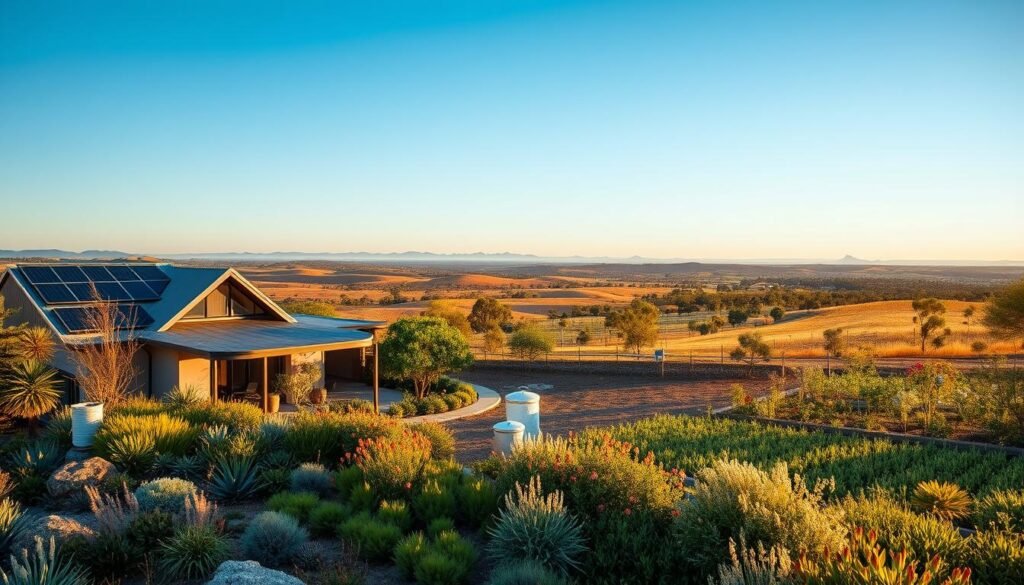
Drought-Resistant Landscaping Techniques
Drought-resistant landscaping involves selecting plants native to Australia that require minimal watering. Techniques such as mulching and using efficient irrigation systems further enhance water conservation. By adopting these strategies, homeowners can maintain beautiful gardens while minimizing water usage.
By incorporating these water efficiency measures, Australian homeowners can contribute to a more sustainable future while also reducing their water bills.
Renewable Energy Solutions for Australian Homes
Renewable energy solutions are becoming a staple in Australian homes, offering a cleaner alternative to traditional energy sources. As the country continues to grapple with the challenges of climate change, homeowners are increasingly turning to renewable energy to power their homes.
The Australian climate varies significantly across different regions, making it essential to adopt renewable energy solutions that are tailored to local conditions. Solar PV systems are particularly well-suited to Australia’s sunny climate, with most regions receiving high levels of solar radiation throughout the year.
Solar PV Systems for Different Australian Climates
Solar PV systems can be designed to maximize energy production in various Australian climates. In tropical regions, for instance, systems are designed to withstand high temperatures and humidity, while in arid regions, they are optimized for dust resistance and high efficiency.
Home Battery Storage Options
Home battery storage systems are becoming increasingly popular as a complement to solar PV systems. These batteries allow homeowners to store excess energy generated during the day for use at night or during power outages, enhancing energy independence and reducing reliance on the grid.
| Feature | Solar PV System | Home Battery Storage |
|---|---|---|
| Primary Function | Generates electricity from sunlight | Stores excess energy for later use |
| Benefits | Reduces electricity bills, lowers carbon footprint | Enhances energy independence, provides backup power |
Wind and Geothermal Alternatives
While solar PV systems are a dominant force in Australian renewable energy, wind and geothermal alternatives also offer promising solutions. Wind turbines can be effective in regions with consistent wind patterns, while geothermal systems tap into the earth’s heat for heating and cooling.
By embracing these renewable energy solutions, Australian homeowners can significantly reduce their reliance on fossil fuels, lowering their carbon footprint and contributing to a more sustainable future.
Creating Healthy Living Environments
In the realm of sustainable housing, creating healthy living environments is a top priority. Sustainable housing designs in Australia are not just about reducing environmental impact; they’re also about fostering spaces that promote occupant health and well-being.
Natural Lighting Optimisation
Maximizing natural lighting is crucial for creating healthy living environments. This can be achieved through strategic window placement and the use of skylights. Some key strategies include:
- Orienting homes to face the north to maximize natural light
- Using reflective surfaces to bounce light deeper into homes
- Incorporating light wells or clerestory windows
Indoor Air Quality Management
Managing indoor air quality is vital for occupant health. This involves effective ventilation systems and air filtration. Key approaches include:
- Implementing mechanical ventilation systems with heat recovery
- Using air-purifying plants or HEPA filters
- Regular maintenance of HVAC systems
Non-Toxic Materials and VOC Reduction
Using non-toxic materials and reducing VOCs (Volatile Organic Compounds) are critical for maintaining indoor air quality. This can be achieved by:
- Selecting materials with low VOC emissions
- Avoiding products containing harmful chemicals
- Ensuring proper ventilation during and after construction
By focusing on these aspects, sustainable housing designs can significantly enhance the health and well-being of occupants, creating truly healthy living environments.
Australian Green Building Standards and Certification
Green building standards are crucial for sustainable development in Australia. These standards ensure that buildings are designed and constructed to minimize environmental impact.
The country has adopted several certification processes to promote green building practices.
Green Star Rating System Requirements
The Green Star Rating System is a widely recognized certification that assesses the sustainability performance of buildings. It evaluates various aspects, including energy efficiency, water usage, and indoor air quality.
NatHERS and Energy Efficiency Ratings
NatHERS (Nationwide House Energy Rating Scheme) is another critical standard that measures the energy efficiency of residential buildings. It provides a rating based on the building’s design and construction.
Passive House Standards in Australian Context
The Passive House Standards focus on creating buildings that are extremely energy-efficient. In Australia, these standards are being adopted to reduce energy consumption and greenhouse gas emissions.
Financial Aspects of Sustainable Housing
Investing in sustainable housing designs in Australia not only benefits the environment but also offers significant financial advantages. While the initial costs may be higher, the long-term savings and benefits can be substantial.
Upfront Costs vs Lifetime Savings Analysis
When considering sustainable housing, it’s crucial to weigh the upfront costs against the potential lifetime savings. Energy-efficient appliances, solar panels, and insulation can significantly reduce utility bills over time. A detailed analysis often reveals that the initial investment pays off through lower energy costs and potentially increased property value.
Federal and State Government Incentives
Australia offers various government incentives for homeowners who invest in sustainable housing. These can include rebates for solar panel installations, grants for energy-efficient upgrades, and tax credits for green building materials. Both federal and state governments provide programs aimed at encouraging eco-friendly construction and renovations.
Property Value and Resale Benefits
Sustainable housing not only saves money on utility bills but can also increase property value. Homes with eco-friendly features are becoming increasingly attractive to buyers, potentially leading to higher resale values. As environmental awareness grows, the demand for sustainable housing is likely to continue rising, making it a smart investment for the future.
Showcase of Leading Australian Sustainable Homes
Australian builders are pushing the boundaries of sustainable housing, creating homes that are both eco-friendly and aesthetically pleasing. These innovative designs are not only reducing environmental impact but also enhancing the quality of life for homeowners.
Urban Eco-Developments in Major Cities
In cities like Melbourne and Sydney, urban eco-developments are setting new standards for sustainable living. For example, the One Central Park development in Sydney features vertical gardens and solar panels, significantly reducing energy consumption. These urban eco-developments are becoming models for future city living.
Rural and Off-Grid Success Stories
In rural areas, off-grid homes are showcasing the potential for sustainable living without reliance on traditional infrastructure. A notable example is the Renewable Energy Hub in Western Australia, which uses solar and wind power to provide energy independence. Such projects demonstrate the viability of off-grid living.
Award-Winning Designs and Innovations
Award-winning sustainable homes are pushing the boundaries of eco-friendly design. The 2022 Australian Sustainable House of the Year featured innovative materials and energy-efficient systems. These designs are not only environmentally friendly but also showcase the future of sustainable housing.
| Project | Location | Key Features |
|---|---|---|
| One Central Park | Sydney | Vertical gardens, solar panels |
| Renewable Energy Hub | Western Australia | Solar and wind power, energy independence |
| 2022 Australian Sustainable House of the Year | Various | Innovative materials, energy-efficient systems |
Conclusion: Embracing a Sustainable Housing Future
Australia’s journey towards a sustainable housing future is gaining momentum, driven by the adoption of eco-friendly homes that not only reduce environmental impact but also enhance the quality of life for residents. As discussed, sustainable housing designs incorporate various elements, including climate-responsive architecture, passive solar design strategies, and the use of sustainable building materials.
The benefits of embracing eco-friendly homes are multifaceted, ranging from reduced energy consumption and lower greenhouse gas emissions to significant financial savings through rebates and incentives, such as those offered under the Small-scale Renewable Energy Scheme (SRES). For more information on sustainable housing, refer to resources like UN-Habitat’s report on Sustainable Housing for Sustainable.
By integrating green renovations and sustainable practices, Australians can contribute to a more environmentally friendly built environment. Examples of effective green renovations include installing solar panels, which can save $3,000/year on electricity, and implementing rainwater harvesting systems, which can reduce mains water usage by up to 50%. For eco-friendly home renovation tips, visit Sustainable Works Australia.
As the demand for sustainable housing continues to grow, it is essential for homeowners, builders, and policymakers to work together to promote eco-friendly practices and create a more sustainable housing future for Australia.
